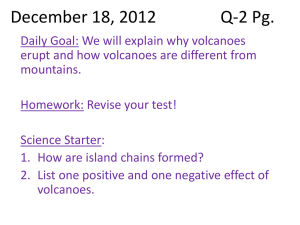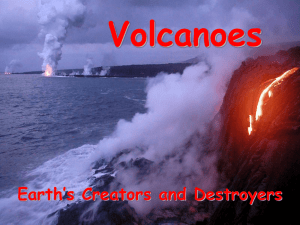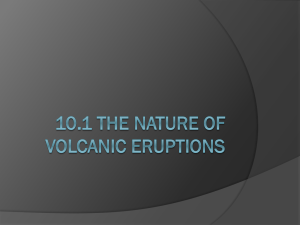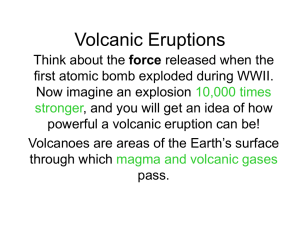pptx
advertisement
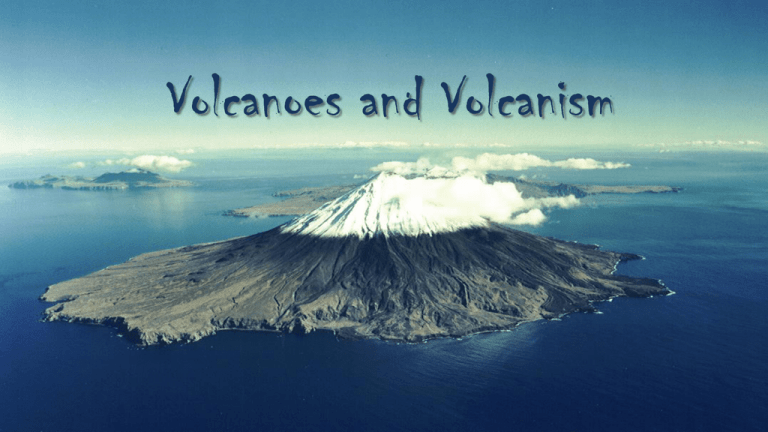
Volcanoes and Volcanism Yellowstone Park is not only spectacular but also unique. It is the result of three volcanic eruptions, the likes of which have never been seen in all of recorded history. The first eruption occurred 2 million years, followed by two more eruptions 1 million years and 600,000 years ago. Below Yellowstone Park there is a hot spot that is generating basaltic magma. At the time of each of their three eruptions, the magma chamber began to produce large volumes of basaltic magma. Because of its low viscosity, the basaltic magma quickly rose to the bottom of the granitic continental crust. However, because the density of basaltic magma (density about 3) is slightly higher than that of granite (density about 2.9) it could not force its way through the granite to the surface. Instead, it began to pool beneath the granitic crust. The amount of heat trapped within the molten basaltic magma was enough to melt the minerals making up the overlaying and surrounding granite, forming a growing mass of granitic magma. Granitic magma is highly viscous and extremely gas-charged. Although it rose only very slowly, the granitic magma advanced upwards by melting even more of its own overlying granitic rock. At some point, radial fractures began to form around the rising mass of granitic magma. These fractures allowed steam eruptions to vent gas. Shortly after, with the overlying granitic rock severely weakened by the fractures, the highly gas-charged granitic magma erupted. The land to a distance of 200 miles in all directions was decimated. Pyroclastic flows, the most destructive eruptive features known, swept across the countryside. Ash fell across the country from the eruption site to the Atlantic Ocean. Ash polluted the world’s atmosphere, blocked the energy of the Sun, and plunged the Northern Hemisphere into a frozen wasteland for years. Can such an eruption occur in the Yellowstone region again? All the evidence suggests that the magma chamber below Yellowstone Park is current rising. According to the director of the Yellowstone Volcanic Observatory, it is not a question of whether or not another super-eruption CAN happen; it’s a question of WHEN it will happen! Extending from Yellowstone Park (yellow), the Snake River Valley (pencil shaded area in illustration) extends to the southwest and ends just off the map near the Oregon-Nevada border. The valley consists of an overlapping series of basalt-filled calderas, each of which formed by a granitic eruption similar to those that formed Yellowstone Park. The hot spot formed at the southwestern end of the Snake River Valley about 16 million years and made its way to the region of Yellowstone about 2 million years ago. The hot spot did not move but the area was carried southwestward over the hot spot by movement of the North American Tectonic Plate. The massive eruptions and the subsequent creation of the calderas literally swallowed up the mountain ranges that originally crossed the region. Each of these eruptions came to an end as the basaltic magma that lay below the granitic magma erupted to the surface and filled the calderas, creating the valley. The fact that there has been no basaltic eruption associated with the Yellowstone event leads many volcanologists to believe that the Yellowstone eruption has not yet come to an end. We might add that the famous Idaho russet potatoes are grown in the soils that formed on the basaltic rocks of the Snake River valley Volcanic islands and/or seamounts that consist of basaltic shield volcanoes have built up by the motion of the Pacific Plate. One such chain is the Hawaiian Island/Emperor Seamount Chain. The motion of the Pacific Plate produces similar linear patterns in the other three chains. The Hawaiian Island/Emperor Seamount chain that extends 3,400 miles (5,400 km) from the Big Island of Hawaii to the Aleutian Trench just south of the Aleutian Islands. The islands extend from the Big Island to Midway, after which they become seamounts. The original explanation for the alignment of the shield volcanoes that appear as islands (seamounts were unknown until the middle 1900s) was that they formed along a fracture that open on the ocean floor beginning under what is now Midway Island. As the crack propagated to the east southeast, other shield volcanoes built above sealevel to form the other islands, ending under the Big Island. However, such a theory did not explain why younger volcanoes couldn’t have been created in the older segment of the chain. Most difficult for the fracture theory to explain, however, is why only the Big Island exhibits active volcanism; all the other volcanoes are extinct. With the advent of plate tectonics, we now know that each shield volcano formed over a hot spot that formed 85 million years ago; a hot spot that is now under the Big Island The alignment of the islands and seamounts records the direction the Pacific oceanic plate was moving over the hot spot. The bend in the chain of seamounts occurred about 45 million years ago. Some geologists believe that the bend represents a change in the direction of movement of the Pacific plate from north-northwest to west-northwest was the result of the collision between the Indian plate and the Asian plate that resulted in the formation of the Himalaya Mountains. Alignment of the Hawaiian Islands is due to movement over a stationary hot spot. A hot spot forms over a mantle plume that creates a basaltic magma by partially melting the peridotite rock at the top of the asthenosphere. Because of the buoyancy of the molten rock, the sea floor over the hot spot is bowed up. As the basaltic magma erupts for the first time, it creates a basaltic shield volcano that builds above sealevel to form a volcanic island. As the oceanic plate moves over the hot spot, it may build other volcanoes that erupt to form other volcanoes on the island, the older structures going extinct as they move off the source of new magma. The Big Island, for example, has five volcanoes, two of which are extinct, one which is on the verge of extinction and two that are active. Actually, a fifth seamount is now rising off the southeastern coast of the Big Island called Loihi that is estimated to reach sealevel in about 50,000 years. After a period of activity, the hot spot apparently goes dormant for perhaps a million years or two. In the meantime, the first volcanic island moves completely off the hotspot and becomes extinct. The hot spot then comes back to life and builds another active volcanic island. By going through a number of cycles of activity/dormancy, a string of islands form, only the one presently over the hot spot is volcanically active; all the others have moved away from the source of magma and are extinct .As the islands move away from the hot spot they get smaller for two reasons, first, erosion is taking its toll but mainly because as the islands move away from the ocean bottom high that formed over the hot spot, the islands are moving into deeper water. Eventually, the islands disappear below sea level and become seamounts. The Cascade Mountain chain is a series of continental arc volcanoes that build in association with a zone of subduction where the Juan de Fuca oceanic plate subducts below the North American plate. The Cascades are interesting in that many of the initial volcanoes were basaltic shield volcanoes that were converted to strato-volcanoes in later life as andesitic magmas began to erupt from their summits. Shield Volcanoes: Most shield volcanoes form over hot spots that are located under the oceanic lithosphere. As the basaltic magma forms over a mantle plume by the partial melting of peridotite at the top of the asthenosphere and forms a magma chamber. The magma then rises and forms another magma chamber within the oceanic lithosphere from which it erupts to the ocean bottom. Because of its low viscosity, the basaltic lava spreads out from the eruption site. Repeated eruptions eventually give rise to a shallow-sloped cone that someone had apparently thought reminded them of the shield carried by ancient warriors; hence the name shield volcano. As long as the volcano remains submarine, it is a seamount. should it build above sealevel, it becomes a volcanic island. Strato- or Composite Volcanoes: Strato- or composite volcanoes form in association with zones of subduction as either continental arc or island arc volcanoes. Because the andesitic magma from which they form has sufficient gas in solution upon erupting to the surface, the eruptions are always explosive. The explosions generate large volumes of rock material referred to as pyroclastic that accumulate around the eruption site, forming a cone with slopes equal to the angle of repose. Following the formation of the pyroclastic cone, the andesitic lavas erupt to seal the cone. This sequence of pyroclastic debris/andesitic lava is repeated during subsequent eruptions, creating a steep-sided volcano that build upward quite fast. Nearly all of the volcanoes you would mention are examples of strato- or composite volcanoes from Mt. Vesuvius to Mount Fuji, to Mt St. Helens.
